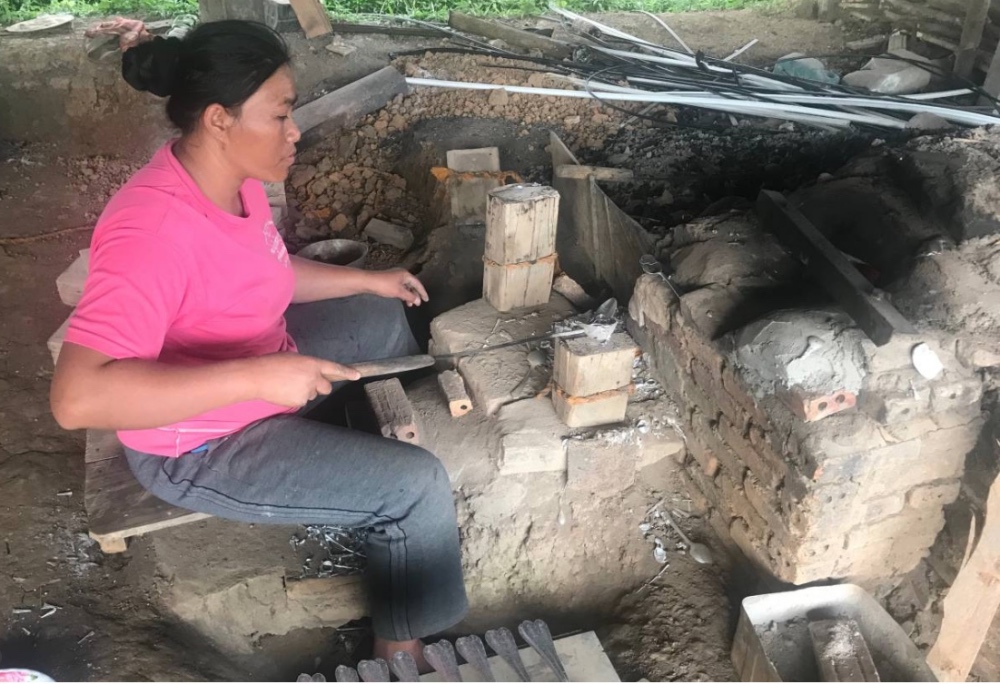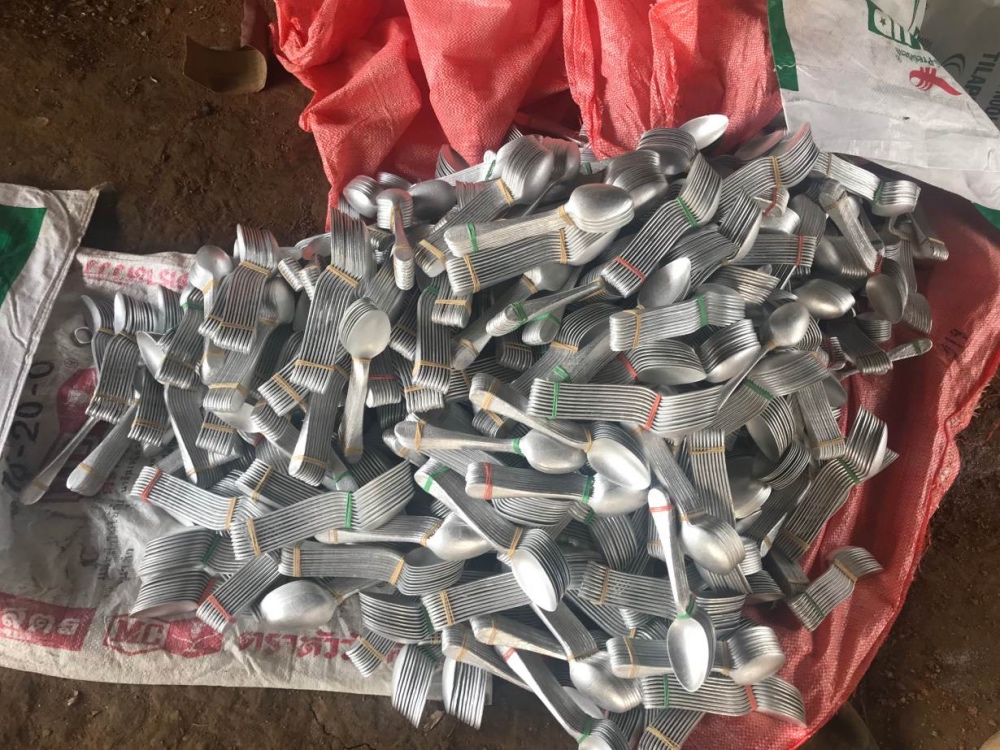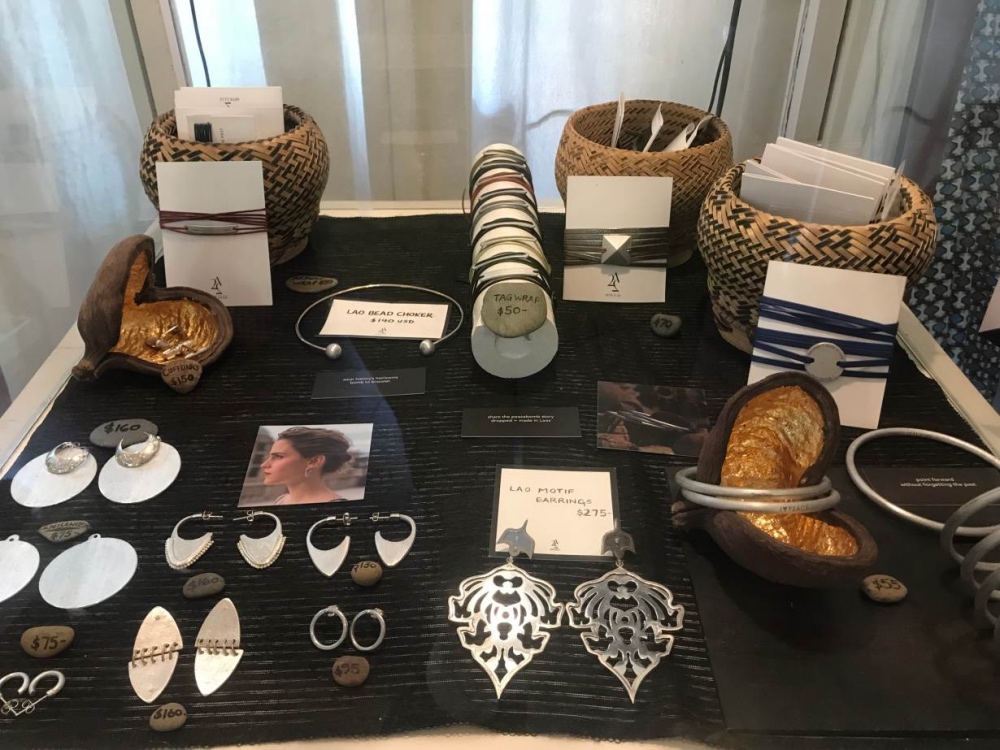
RINA CHANDRAN, of Thomson Reuters Foundation, reports…
With a long-stemmed ladle, Vanthon pulls shiny, molten metal from a kiln and deftly pours it into a mould carved in a wooden block.
Seconds later, she prises out a silver coloured dove that was once shrapnel from a bomb dropped in Ban Napia village in the north eastern province of Xieng Khouang in Laos, the most heavily bombed country per capita in the world.

A woman fashions items from bomb shrapnel at her kiln in Ban Napia, Laos, on 16th October. PICTURE: Rina Chandran/Thomson Reuters Foundation.
Vanthon, who goes by one name, grows rice in a small plot of land a short distance away. But the ornaments and jewellery made from scrap metal in the small kiln at home provide her husband with an income.
For the dozen families in the village who fashion jewellery from shrapnel for the New York-based company Article 22, it is a curious twist to the devastating war – one that helps them make a living from bombs, as they wait for their land to be cleared.
“Our field has not yet been cleared of bombs, so this is our main source of income for now.”
– Vanthon, who makes items from bomb fragments.
“Our field has not yet been cleared of bombs, so this is our main source of income for now,” said Vanthon, gesturing to a pile of finished doves.
“We have to be careful while farming, and hope that a bomb does not go off. When the land is cleared, we can farm more.”
The United States dropped more than two million tons of cluster bombs on Laos during the second Indochina War from 1964 to 1973, to disrupt supply routes to North Vietnam.
About 30 per cent of those bombs did not detonate, and still pose the risk of death or injury to villagers as they go about their daily routines, according to Mines Advisory Group, a British charity that clears unexploded ordnance (UXO).
MAG estimates that about 1,600 square kilometres of land – roughly the size of Greater London – still needs clearing in Laos, one of the world’s poorest countries.
Meanwhile, UXO contamination prevents Lao communities from “fully utilising their land” and earning better incomes, according to MAG.
“People have been living with the contamination for 40 years, and they have no choice but to live with the daily risk and fear of death or injury from unexploded bombs,” said Greg Crowther, MAG’s Southeast Asia director.
UXO-impacted communities are “predominantly the poorest members of society”, and the risk of bombs forces them to adopt different farming practices that often reduce the productivity of their crops, he said.

A pile of items made from bomb shrapnel by villagers in Ban Napia, Laos. PICTURE: Rina Chandran/Thomson Reuters Foundation.
More than of two-thirds of the population in the landlocked South-East Asian country depends on the land for a living, according to government data.
Many farm small plots of land that they do not legally own.
The government aims to title all land by 2025, and introduce a new law that officials say will expedite modernisation of records and give greater tenure security.
The country is also luring more foreign investment to build much-needed infrastructure and generate jobs, but most villagers have few livelihood options, particularly in Xieng Khouang, where much of the land is still off-limits because of the bombs.
Elizabeth Suda, founder of Article 22, first visited the province about a decade ago while exploring a sustainable weaving venture with local women.
It was there that Suda, who had previously worked with a luxury brand in New York, came across villagers melting bomb shrapnel into spoons that they would use and sell in the local market.
She said she had an “a-ha moment”.
“I thought, why not take a weapon of destruction and turn it into a symbol of love that has a positive impact on the community?”
– Elizabeth Suda, founder of Article 22.
“I thought, why not take a weapon of destruction and turn it into a symbol of love that has a positive impact on the community?” she told the Thomson Reuters Foundation.
“These are subsistence farmers; having their land cleared makes a big difference. But until then, they can earn a living making jewellery from shrapnel they find.”
Suda founded Article 22 in 2009, named for the clause in the Universal Declaration of Human Rights that says every individual is entitled to the realisation of “economic, social and cultural rights” indispensable for his or her dignity and personality.
After partnering with Swiss non-profit Helvetas, Suda set out on her own, selling online and through a few retail outlets, including one in Luang Prabang, Laos’ former royal capital that the UN cultural agency considers a world heritage site.
Suda works with about a dozen families in Xieng Khouang, sending designs for earrings, pendants and ornaments that the villagers fashion in their kilns. They are finished in capital Vientiane, then shipped to New York.
Article 22 only works with shrapnel, or bombs that have already exploded, so the villagers are not at risk, Suda said. The metal has been tested for toxicity and found to be safe.
Some of the profits are donated to MAG to clear UXOs.

Jewellery, branded “Article22”, made from bomb shrapnel are displayed in a store in Luang Prabang, Laos. PICTURE: Rina Chandran/Thomson Reuters Foundation.
Unlike neighbouring Vietnam, which draws millions of tourists each year keen to visit sites related to the war with the United States, Laos has few Instagram-ready war attractions.
In villages in Xieng Khouang, remnants of the “secret war” are largely articles of everyday use – mugs and buckets fashioned from shell casings, ladles from shrapnel.
Article 22 received a huge boost when actor Emma Watson wore a pair of its earrings at a red carpet event in 2017.
There is little glamour in Ban Napia, whose sign declares it to be the “war spoon village”.
Simple wood and concrete homes sit on either side of a mud road. Some have a handpainted sign that says “making spoon”, with a name and a phone number.
Demining is a slow and expensive process, and at the current pace, experts say it could be more than 100 years before Laos is safe.
While waiting for their land to be cleared, villagers in Ban Napia and elsewhere in Xieng Khouang will probably continue to supplement their income with articles made from shrapnel, said Nouds Phedrasy, a tourist guide.
“In the years after the war, they had nothing, and had to make do with whatever they could find – including shell casings and shrapnel,” he said.
“Now, it’s a business, and they are aware of the irony. But it is just a way to make some money.”





